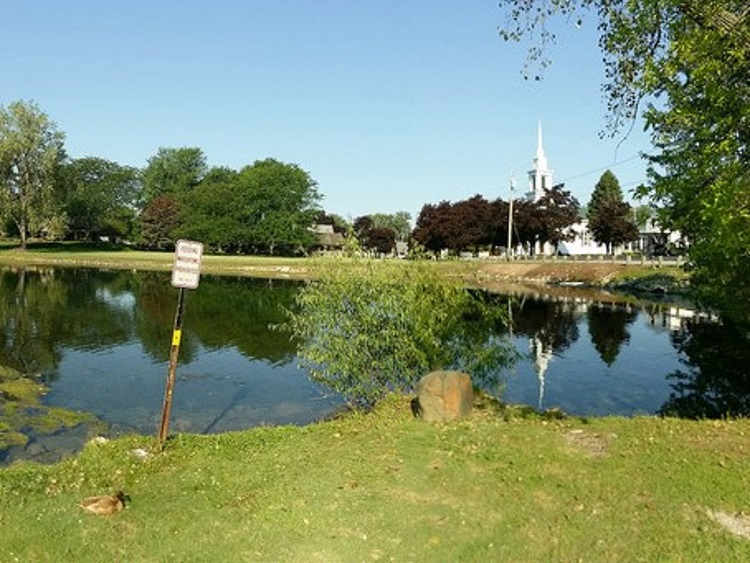Castalia Pond

Castalia Pond
Spring Street Castalia, Ohio 44824
Also, see all the hotspots at:
Lake Erie Western Basin Important Bird Area
Castalia Birding Drive
Tips for Birding
This pond of approximately 10 acres is a “blue hole”; a spring that stays open year-round attracting large concentrations of waterfowl after the freeze-up of the Sandusky Bay region, typically the 3rd week of December. The optimal time for visitation is 1 January through 10 February, although any visit after 1 November and through 10 March can be rewarding. Numbers have reached 17,000 birds (in the late 70’s) although in recent decades the high count has been 11,000, and more typically the concentration peaks at 7-8000 ducks and 1000 geese.
Mild seasons, with little ice on Lake Erie in the Western Basin, allow waterfowl to disperse, so check ice conditions on lake Erie. January is by far the most consistent month for optimal viewing. Most are Mallards and formerly up to 2500 American Black Ducks. One can expect 12-14 species of ducks and perhaps 2-3 other water birds on any given day. What makes Castalia Pond a “must visit” during winter is the close proximity with which one may study or photograph the birds. Examining waterfowl for either reading the numbers on goose collars, plumage study of the numerous hybrids, or other age and sex details, is afforded here like few other sites.
The Mallard X American Black Duck hybrid is the most common, but Mallard X Northern Pintail and the Mallard X Gadwall (Brewer’s Duck) has also been recorded here. Be sure to check out the downstream outflow areas which can harbor more secretive species like Wood Duck, Hooded Merganser, and Pied-billed Grebe.
Castalia is just 3 miles off OH-2 in Erie County. Traveling on OH-2, from the east, take the SR 101 exit and drive south 3 miles into Castalia. This brings you directly to the north side of the pond and also to one of the two parking areas.
From the west, on OH-2, take OH-SR 269 SOUTH exit (the first one available once across the Sandusky Bay bridge), and head south (a right onto OH-269). In 2 miles, take a right onto US-6. In less than a mile turn left at the sign for Castalia. This brings you into town and from this stop light, a left turn will take you to the north side of the pond, or continue straight through the light and make the first left (at the bank). This will take you to a parking area on the south side of the pond.
This city park is always open.
Parking is located on the north and south sides of the pond.
Be watchful of young children who may be fascinated by the ducks and wander too close to the water’s edge.
Castalia Pond is a stop on the Lake Erie Birding Trail.
Birds of Interest
Winter
Waterfowl diversity and numbers here are among the highest found in northern Ohio. Specialties include a consistent, over-wintering population of American Wigeon, Gadwall, and Northern Shoveler. There are four records of the Eurasian Wigeon here, including an over-wintering bird. The Blue-winged Teal has over-wintered here for one of a very few documented records. There are several records of Snow Goose and Greater White-fronted Goose, including a very rare mid-winter record. This is one of the few locations in northern Ohio to consistently have Ring-necked Duck and Northern Pintail over winter. Occasional Pied-billed Grebe, American Coot, and Belted Kingfisher augment the usual waterfowl. Gulls are few but a Lesser Black-backed Gull visited in February 2004. Blackbirds visit the area feeders and the Brewer’s Blackbird has also been recorded. Bald Eagles are resident in the area and are frequently seen overhead on sunny days. The mid-winter roost of American Robins has approached 1000 birds making it one of the largest in northwest Ohio. Golden-crowned Kinglet, Brown Creeper, Hermit Thrush, and Yellow-rumped Warbler over-winter in the area. Cooper’s Hawks are in residence and frequently hunt the area.
Spring
Fewer numbers of birds are found here into early April. You may see all six swallows species here around 1 May and the water may attract concentrations of breeding-plumaged Bonaparte’s Gull.
Summer
Only a few, locally breeding Mallards and Canada Geese remain.
Fall
Ducks begin arriving with the fall teal season in September when Blue-winged Teal may number 100 or more. Greater White-fronted Goose has been recorded here by late October. Winter waterfowl composition starts to take shape in early November when peak numbers of Gadwall and American Wigeon arrive.
About this Location
Castalia Pond is often called the “Duck Pond,” and with good cause. Waterfowl are the highlights of this 10-acre pond, which is fed by artesian springs and remains ice-free throughout winter. Over 10,000 ducks and geese can congregate in favorable winters. The fowl become accustomed to people, and close-up views are the norm, along with great photographic opportunities.
Features
Restrooms on site
Content from Ohio Ornithological Society